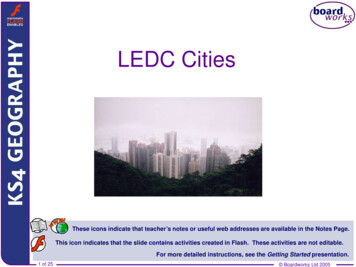
Transcription
LEDC CitiesThese icons indicate that teacher’s notes or useful web addresses are available in the Notes Page.This icon indicates that the slide contains activities created in Flash. These activities are not editable.For more detailed instructions, see the Getting Started presentation.1 of 25 Boardworks Ltd 2005
Learning objectivesWhat is the global pattern of urbanisation?Why is urbanisation happening in LEDCs?What problems do LEDC cities face?What are the solutions?How does land use vary in an LEDC city?2 of 25 Boardworks Ltd 2005
What is urbanisation?3 of 25 Boardworks Ltd 2005
What is urbanisation?The world is becoming mostly DC17344156Study the table.Which parts of the world are experiencing the mostrapid growth in their populations?4 of 25 Boardworks Ltd 2005
Where are the world’s largest cities?There are 17 megacities in the world – these arecities with a population of over 10 million.5 of 25 Boardworks Ltd 2005
Where are the world’s largest cities?The United Nations estimate that by 2015 the number ofmegacities will have increased to 21!new megacities are shown in orangeDescribe the distribution of megacities in 2000.How does this compare to 2015?6 of 25 Boardworks Ltd 2005
Learning objectivesWhat is the global pattern of urbanisation?Why is urbanisation happening in LEDCs?What problems do LEDC cities face?What are the solutions?How does land use vary in an LEDC city?7 of 25 Boardworks Ltd 2005
Focus on KenyaDescribe the pattern of growth of Nairobi since 1901.8 of 25 Boardworks Ltd 2005
Why is urbanisation occurring so rapidly?9 of 25 Boardworks Ltd 2005
Rural-urban migrationThis is the movement of people from the countrysideto the city.It is influenced by PUSH and PULL factors.10 of 25 Boardworks Ltd 2005
Learning objectivesWhat is the global pattern of urbanisation?Why is urbanisation happening in LEDCs?What problems do LEDC cities face?What are the solutions?How does land use vary in an LEDC city?11 of 25 Boardworks Ltd 2005
Problems facing LEDC citiesOver 60% of Nairobi’s population live below the poverty line.Over 500 000 people live in Kibera which is a shanty town onthe Southern edge of Nairobi opposite the Motoine River.A shanty town is a spontaneous settlement that isoften built illegally on unused land along roadsides oron the edge of a city.12 of 25 Boardworks Ltd 2005
Kibera13 of 25 Boardworks Ltd 2005
Favela – Brazil14 of 25 Boardworks Ltd 2005
15 of 25 Boardworks Ltd 2005
Issues in theFavela Built on steep,marshy, polluted,illegal land. Sanitation – disease Healthcare Unemployment Crime No refuse collectionor public services16 of 25 Boardworks Ltd 2005
Favelas - Possible solutionsSelf-help schemes –City authorities would prefer to removethe shanty towns but this would cost alot of money as they would have toprovide housing and amenities.As a result the city authority hasimplemented self-help schemes. Thisinvolves the city authority giving theresidents of the shanty town freebuilding materials. The residents thenprovide the labour in order to build thenew houses.Money that is saved by the governmentcan then be spent on infrastructure suchas roads, water supply, electricity etc.http://www.youtube.com/watch?v dzrBL2EwrI17 of 25 Boardworks Ltd 2005
Self Help Scheme Self-help schemes - These are small scale projects which allowlocal people to use their skills to help improve their local area. TheGovernment has provided materials such as bricks, cement andglass to enable residents to improve their own homes. In Rocinha,self-help schemes have improved the area from slums to low qualityhousing where the majority of homes have basic services likeelectricity. There are now also many services in Rocinha includingcafes and shops. Some people have been granted legal ownershipof the land on which their houses are built.18 of 25 Boardworks Ltd 2005
Site and service scheme Site and service schemes - These are projectsundertaken by the local authority to relocate residentsfrom favelas. Brick houses are built with electricity,running water and sanitation pipes installed. People maybe allowed to buy these houses. An example of such ascheme is 'The Favela Bairro Project' or 'Slum toNeighbourhood' project. Services in these areas alsoinclude refuse collection, schools and health centres.19 of 25 Boardworks Ltd 2005
Charities Charities - Charities help to improve life for people inshanty towns by providing money for self-help schemes.The Developing Minds Foundation builds schools andsupports education programmes in Rio's favelas. Theiraim is to improve the literacy rates of children so theycan get a good job, improve their standard of living andhave more life choices.20 of 25 Boardworks Ltd 2005
Crime http://www.youtube.com/watch?v /lifein-the-favela-of-rochina/1693.html21 of 25 Boardworks Ltd 2005
1) Look at the diagram.For Nairobi, or any other developing city you have studied, describethe measures taken to improve the quality of life in shanty towns suchas Kibera.(6)22 of 25 Boardworks Ltd 2005
Extension Task.Imagine that you are a resident in a favela for a day. Create a diaryentry outlining: The current issues in your home and shanty town. The recent developments which help to deal with these issues.Your diary entry must include: A title A definition of a favela At least four different problems in yourshanty town. What possible solutions there could beto these problems.23 of 25 Boardworks Ltd 2005
24 of 25 Boardworks Ltd 2005
Transport As with most large cities many main roads and transport networksmeet in the city centre as this is where the majority of offices, shopsetc are, so this is where people work and therefore travel into mostdays. As a result traffic congestion is a major problem especiallyduring rush hour in the morning and in the evening where mainroads become one way (into the city in the morning and out of thecity in the evening) in an attempt to try to ease the problem. Buses are available but are often overcrowded, dangerous andpickpockets usually operate. They are also regularly stuck in traffic.A metro (subway) system was opened in 2007 to help combat thecongestion. It is rapidly expanding, air conditioned, quick and safe.25 of 25 Boardworks Ltd 2005
Shopping The CBD of developing countries will often resembledeveloped world cities in that they will have largeshopping centres containing department stores andother high order shops such as jewellers and furniturestores. Rio de Janeiro's 'Shopping Leblon' and 'Shoppingda Gavea' are two of the biggest shopping malls in thecity. There are also some street markets e.g. FieraHippie although not as many as in other developingworld cities. Street markets sell fruit, vegetables,handicrafts, artwork, music and clothes.26 of 25 Boardworks Ltd 2005
Environmental Quality In 2011, a World Health Organisation (WHO) study said that Rio de Janeiro is morepolluted than many other developed world cities such as New York, London andParis. Most of this is air pollution with the main pollutants being:Exhaust fumes from trafficCoal-fired power stationsResidential wood burning for cooking and heatingBurning rubbish in rubbish dumpsThere is also severe pollution of rivers from:Untreated run-off of water used by the population going back into riversRubbish dumped into and at the side of rivers potentially promoting diseaseWastewater from industry being put back into rivers which also kills wildlifeHarbour polluted from increase in boat trafficSome solutions to these include better laws to control dumping of industrial wasteand the improvement of sanitation in shanty town areas. The state government hasalso committed funds to clean up beaches and lakes and also to provide improvedsewage treatment facilities27 of 25 Boardworks Ltd 2005
Examination questionFor a named example of an LEDC city, describe theproblems created by rapid urban growth (6 marks).28 of 25 Boardworks Ltd 2005
Learning objectivesWhat is the global pattern of urbanisation?Why is urbanisation happening in LEDCs?What problems do LEDC cities face?What are the solutions?How does land use vary in an LEDC city?29 of 25 Boardworks Ltd 2005
Is there a solution?The Kenyan government isconcerned about the growth ofillegal settlements, but it is notpractical to evict all the peopleas the scale of the problem istoo big.What could be done in Kibera?Rubbish in Kibera30 of 25 Boardworks Ltd 2005
What has been done in Kibera?31 of 25 Boardworks Ltd 2005
Characteristics of shanty town housing32 of 25 Boardworks Ltd 2005
Solving the housing problem33 of 25 Boardworks Ltd 2005
Examination question34 of 25 Boardworks Ltd 2005
Learning objectivesWhat is the global pattern of urbanisation?Why is urbanisation happening in LEDCs?What problems do LEDC cities face?What are the solutions?How does land use vary in an LEDC city?35 of 25 Boardworks Ltd 2005
Land use patterns in LEDC citiesHow can this land use pattern be explained?36 of 25 Boardworks Ltd 2005
Differences in land use?LEDCMEDC37 of 25Choose one of themodels and explainthe land use pattern. Boardworks Ltd 2005
How much do you know?38 of 25 Boardworks Ltd 2005
Key ideasThe world is becoming mostly urban.Urbanisation is now happening most rapidly in LEDCs.There will be 21 megacities by 2015 – 16 of them inLEDCs.Rural-urban migration is the result of push and pullfactors.Shanty towns are one problem resulting from rapidurbanisation.It is difficult to manage rapid urbanisation.The pattern of land use in LEDC cities is different to that ofmost MEDC cities.39 of 25 Boardworks Ltd 2005
Over 500 000 people live in Kibera which is a shanty townon the Southern edge of Nairob











